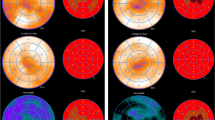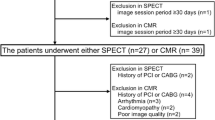Abstract
Software packages are widely used for quantification of myocardial perfusion defects. The quantification is used to assist the physician in his/her interpretation of the study. The purpose of this study was to compare the quantification of reversible perfusion defects by three different commercially available software packages. We included 50 consecutive patients who underwent myocardial perfusion single-photon emission tomography (SPET) with a 2-day technetium-99m tetrofosmin protocol. Two experienced technologists processed the studies using the following three software packages: Cedars Quantitative Perfusion SPECT, Emory Cardiac Toolbox and 4D-MSPECT. The same sets of short axis slices were used as input to all three software packages. Myocardial uptake was scored in 20 segments for both the rest and the stress studies. The summed difference score (SDS) was calculated for each patient and the SDS values were classified into: normal (<4), mildly abnormal (4–8), moderately abnormal (9–13), and severely abnormal (>13). All three software packages were in agreement that 21 patients had a normal SDS, four patients had a mildly abnormal SDS and one patient had a severely abnormal SDS. In the remaining 24 patients (48%) there was disagreement between the software packages regarding SDS classification. A difference in classification of more than one step between the highest and lowest scores, for example from normal to moderately abnormal or from mildly to severely abnormal, was found in six of these 24 patients. Widely used software packages commonly differ in their quantification of myocardial perfusion defects. The interpreting physician should be aware of these differences when using scoring systems.

Similar content being viewed by others
References
Berman DS, Kiat H, Friedman JD, Wang FP, van Train K, Matzer L, Maddahi J, Germano G. Separate acquisition rest thallium-201/stress technetium-99m sestamibi dual-isotope myocardial perfusion single-photon emission computed tomography: a clinical validation study. J Am Coll Cardiol 1993; 22:1455–1464.
Lindahl D, Lanke J, Lundin A, Palmer J, Edenbrandt L. Improved classifications of myocardial bull’s-eye scintigrams with computer-based decision support system. J Nucl Med 1999; 40:96–101.
Hachamovitch R, Berman DS, Kiat H, Cohen I, Cabico JA, Friedman J, Diamond GA. Exercise myocardial perfusion SPECT in patients without known coronary artery disease: incremental prognostic value and use in risk stratification. Circulation 1996; 93:905–914.
Hachamovitch R, Berman DS, Shaw LJ, Kiat H, Cohen I, Cabico JA, Friedman J, Diamond GA. Incremental prognostic value of myocardial perfusion single photon emission computed tomography for the prediction of cardiac death: differential stratification for risk of cardiac death and myocardial infarction. Circulation 1998; 97:535–543.
Zellweger MJ, Lewin HC, Lai S, Dubois EA, Friedman JD, Germano G, Kang X, Sharir T, Berman DS. When to stress patients after coronary artery bypass surgery? Risk stratification in patients early and late post-CABG using stress myocardial perfusion SPECT: implications of appropriate clinical strategies. J Am Coll Cardiol 2001; 37:144–152.
Verberne HJ, Habraken JB, van Royen EA, Tiel-van Buul MM, Piek JJ, van Eck-Smit BL, Verbeme HJ. Quantitative analysis of99Tcm-sestamibi myocardial perfusion SPECT using a three-dimensional reference heart: a comparison with experienced observers. Nucl Med Commun 2001; 22:155–163.
Germano G, Kavanagh PB, Waechter P, Areeda J, Van Kriekinge S, Sharir T, Lewin HC, Berman DS. A new algorithm for the quantitation of myocardial perfusion SPECT. I. Technical principles and reproducibility. J Nucl Med 2000; 41:712–719.
Sharir T, Germano G, Waechter PB, Kavanagh PB, Areeda JS, Gerlach J, Kang X, Lewin HC, Berman DS. A new algorithm for the quantitation of myocardial perfusion SPECT. II. Validation and diagnostic yield. J Nucl Med 2000; 41:720–727.
Van Train KF, Areeda J, Garcia EV, Cooke CD, Maddahi J, Kiat H, Germano G, Silagan G, Folks R, Berman DS. Quantitative same-day rest-stress technetium-99m-sestamibi SPECT: definition and validation of stress normal limits and criteria for abnormality. J Nucl Med 1993; 34:1494–1502.
Van Train KF, Garcia EV, Maddahi J, et al. Multicenter trial validation for quantitative analysis of same-day rest-stress technetium-99m-sestamibi myocardial tomograms. J Nucl Med 1994; 35:609–618.
Ficaro EP, Kritsman JN, Corbett JR. Development and clinical validation of normal Tc-99m sestamibi database: comparison of 3D-MSPECT to Cequal. J Nucl Med 1999; 40:125.
Ficaro F, Liu YH, Wackers FJT, Corbett JR. Evaluation of 3-D MSPECT for quantification of Tc-99m sestamibi defect size. J Nucl Med 1999; 40:181.
De Sutter J, Van de Wiele C, D’Asseler Y, De Bondt P, De Backer G, Rigo P, Dierckx R. Automatic quantification of defect size using normal templates: a comparative clinical study of three commercially available algorithms. Eur J Nucl Med 2000; 27:1827–1834.
Widding A, Hesse B, Gadsboll N. Technetium-99m sestamibi and tetrofosmin myocardial single-photon emission tomography: can we use the same reference data base? Eur J Nucl Med 1997; 24:42–45.
Acknowledgements
This study was supported by grants from the Swedish Medical Research Council (09893) and the Swedish Heart Lung Foundation.
Author information
Authors and Affiliations
Corresponding author
Rights and permissions
About this article
Cite this article
Svensson, A., Åkesson, L. & Edenbrandt, L. Quantification of myocardial perfusion defects using three different software packages. Eur J Nucl Med Mol Imaging 31, 229–232 (2004). https://doi.org/10.1007/s00259-003-1361-4
Received:
Accepted:
Published:
Issue Date:
DOI: https://doi.org/10.1007/s00259-003-1361-4




